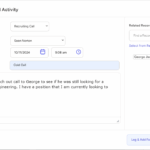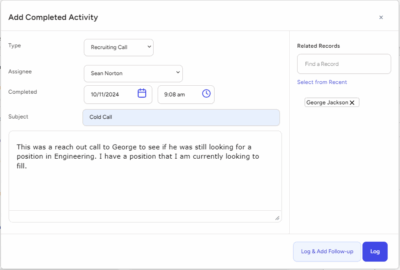In today’s highly competitive job market, the demand for top talent is greater than ever. With the proliferation of online platforms, mobile apps, and social media, the recruitment landscape has evolved dramatically. Traditional methods of advertising job vacancies—like posting paper ads or waiting for resumes to flood your inbox—are a thing of the past. Today’s recruiters need to be tech-savvy, proactive, and adept at leveraging powerful platforms like LinkedIn to source and engage top candidates.
With over 575 million users, LinkedIn has become the go-to platform for professionals to showcase their skills, network with peers, and engage with potential employers. LinkedIn isn’t just a place to list job vacancies—it’s a comprehensive tool that, when used correctly, can streamline the recruitment process, making it faster and more efficient.
In this article from Top Echelon Recruiting Software, we’ll dive deep into how recruiters can harness the full power of LinkedIn, with updated tips and best practices to help you attract and retain top talent more effectively.
1. Keep Your LinkedIn Profile Updated Regularly
First impressions are crucial in recruitment, and as a recruiter, your LinkedIn profile is often the first point of contact with potential candidates. Having a strong, up-to-date profile not only establishes your credibility but also makes you more approachable and trustworthy. A well-optimized profile acts as a calling card for the professionalism you bring to the table.
Here are some key elements to keep in mind when updating your profile:
- Professional Headshot: Use a high-quality, professional headshot that reflects your role. LinkedIn profiles with photos are 14 times more likely to be viewed.
- Detailed Experience Section: Clearly list your past and present job roles, focusing on your responsibilities and achievements in recruitment. Be specific about your areas of expertise, such as sourcing, candidate engagement, or industry specialization.
- Accurate Headline: Your headline should clearly communicate your current role and what you bring to the table. A concise headline such as “Recruiter specializing in IT & Software Engineering | Helping companies find top talent” can immediately communicate your value.
- Engagement: Consistently engage with posts, articles, and updates. By liking, commenting, or sharing relevant content, you increase your visibility in your network’s feed. This makes you more memorable and approachable, which is especially useful when you’re actively seeking candidates.
Beyond these basics, building a strong personal brand on LinkedIn can further enhance your recruitment efforts. Regularly posting insights about your industry or success stories about candidate placements can position you as a thought leader in your niche. Testimonials from candidates or hiring managers are another powerful tool to bolster your credibility. These can act as social proof, showing potential candidates that you are a recruiter who delivers results.
2. Build and Maintain LinkedIn Groups: Nurturing a Community of Candidates
LinkedIn Groups are an underutilized yet highly effective tool for recruiters. A well-managed group can act as a community where professionals gather to share insights, discuss industry trends, and, most importantly, engage with job opportunities.
As a recruiter, creating a LinkedIn group aligned with your industry can serve several purposes:
- Community Building: Groups offer a space for candidates and professionals to engage in meaningful discussions, share content, and stay updated on industry developments. This builds trust and rapport over time, making group members more likely to approach you when they’re ready to explore new opportunities.
- Exclusive Job Postings: Groups can be a great place to post job opportunities that may not be available elsewhere. Candidates who are part of your group may feel a sense of exclusivity and are more likely to engage with these postings.
- Establishing Authority: By regularly contributing valuable content to your group—such as blog posts, industry news, or recruitment tips—you position yourself as an expert in the field. Candidates are more likely to trust a recruiter who consistently demonstrates knowledge and insight.
When managing a LinkedIn group, it’s essential to stay active and engaged. Post regularly, moderate discussions to ensure they remain relevant, and encourage group members to contribute. Over time, a well-managed group can become a gold mine of qualified candidates, especially if you are recruiting for a niche industry or specialized roles.
3. Leveraging LinkedIn InMail: Personalized Outreach for Higher Engagement
LinkedIn’s InMail feature allows you to send direct messages to users who aren’t in your network. This is a powerful tool for reaching out to passive candidates who may not be actively seeking a new role but could be open to the right opportunity. With email open rates often declining, LinkedIn InMail offers a much more efficient alternative for candidate outreach.
According to LinkedIn, the average response rate to InMail is as high as 85%, a significant improvement over traditional email campaigns. To make the most of InMail, however, you need to ensure your messages are personalized and relevant.
Here are a few tips for using InMail effectively:
- Personalization is Key: Generic messages are more likely to be ignored. Take the time to review a candidate’s profile, identify common connections, or mention something specific about their experience that makes them a good fit for the role. For example, you could say, “I noticed your experience managing cloud infrastructure projects, which aligns perfectly with an exciting opportunity I’m working on.”
- Get to the Point: While it’s important to personalize your message, it’s equally important to keep it concise. Candidates are busy, and a lengthy message can be a turn-off. Focus on the value you’re offering, and invite them to explore the opportunity further.
- Include a Call to Action: End your message with a clear next step, such as setting up a call or asking for their availability to discuss the opportunity. A simple, direct request increases the likelihood of a response.
Using InMail strategically allows you to connect with high-potential candidates who might otherwise be off your radar. The key is to create messages that stand out in a candidate’s inbox and make them want to engage with you.
4. Using Applicant Tracking Systems (ATS) to Streamline LinkedIn Recruitment
Recruiting is a data-driven process, and utilizing an Applicant Tracking System (ATS) that integrates with LinkedIn can significantly streamline your workflow. An ATS helps you manage candidates, track communication, and organize your recruiting efforts in one central platform.
Many ATS platforms offer browser extensions that allow you to pull candidate data directly from LinkedIn into your database. This data often includes contact information, work history, and skills, making it easier to maintain a comprehensive record of potential candidates. Instead of manually inputting details or sorting through profiles, an ATS automates much of the legwork, allowing you to focus on building relationships and making placements.
Benefits of Using an ATS with LinkedIn Integration:
- Centralized Candidate Data: Automatically capture and store candidate profiles from LinkedIn into your ATS, ensuring that all information is organized and accessible in one place.
- Candidate Tracking: Keep track of where each candidate is in the recruitment process. With an ATS, you can easily see which candidates have been sourced, interviewed, or placed, ensuring no one slips through the cracks.
- Improved Candidate Experience: By using an ATS to streamline your workflow, you can ensure faster communication with candidates. The quicker and smoother your recruitment process, the better experience candidates will have, which can positively influence their decision to accept an offer.
- Automated Reporting and Analytics: Most ATS platforms offer reporting features that allow you to track key recruitment metrics such as time-to-fill, sourcing effectiveness, and candidate engagement. These insights can help you optimize your LinkedIn recruiting strategy over time.
5. Engaging with Both Active and Passive Candidates: The Key to a Robust Talent Pipeline
One of LinkedIn’s greatest strengths as a recruiting platform is its ability to help you engage both active and passive candidates. Active candidates are those who are actively seeking a new role, while passive candidates may not be looking for a job but could be open to the right opportunity.
Engaging Active Candidates:
For active candidates, it’s important to ensure your job postings on LinkedIn are clear, concise, and optimized with the right keywords. Active job seekers will often use LinkedIn’s job search functionality to find roles that match their skills and experience, so using targeted language in your job descriptions is crucial. Highlight key responsibilities, required qualifications, and what makes the role unique. If the job listing is compelling, you’ll attract more qualified applicants.
Engaging Passive Candidates:
When it comes to passive candidates, your approach needs to be more nuanced. Passive candidates aren’t scouring job boards, so you need to actively reach out and sell the opportunity to them. This is where features like LinkedIn InMail and personalized outreach come into play.
Passive candidates are more likely to engage with opportunities that promise career advancement, improved work-life balance, or exciting challenges. By taking the time to understand their current role and pain points, you can tailor your messaging to resonate with their long-term career aspirations. Building relationships with passive candidates over time will help you cultivate a pipeline of qualified talent, ensuring you’re never scrambling to fill a role.
Harnessing the Power of LinkedIn for Recruitment Success
LinkedIn has revolutionized the way recruiters and businesses source talent. By leveraging the platform’s extensive network, recruiters can tap into both active and passive candidates, engage them effectively, and build a robust talent pipeline. To make the most of LinkedIn, recruiters must keep their profiles updated, build relevant groups, utilize LinkedIn InMail for outreach, and integrate with an ATS to streamline their process.
In a world where top talent is increasingly in demand, using LinkedIn as a recruiting tool can provide a significant competitive edge. With consistent effort and a strategic approach, you can transform your LinkedIn presence into a powerful asset for sourcing and hiring the best candidates, ensuring long-term success for both your organization and your clients.








